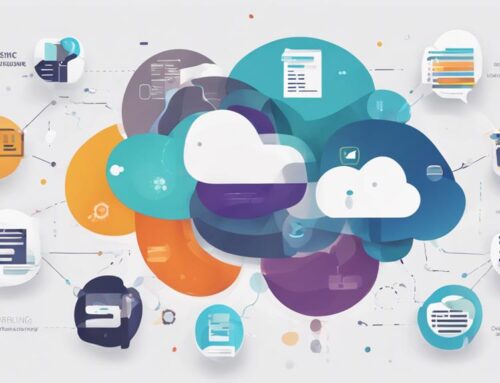As you navigate the landscape of data management outsourcing, one prominent trend that demands your attention is the integration of AI-powered solutions into data processes. The strategic implementation of artificial intelligence has revolutionized the way businesses handle data, offering unparalleled insights and operational efficiencies. But what are the other nine key trends in data management outsourcing? Stay tuned to uncover the latest developments that are reshaping the industry and driving organizations towards greater success.
AI-Powered Data Management
Data management is rapidly evolving, with AI-powered solutions leading the charge. Machine learning integration plays a vital role in enhancing data management processes. By leveraging AI algorithms, organizations can automate tasks such as data categorization, anomaly detection, and predictive analytics, leading to increased efficiency and accuracy.
One key aspect of AI-powered data management is data quality optimization. Through machine learning algorithms, companies can identify and rectify inconsistencies, duplications, and errors in their datasets. This optimization process ensures that the data being used for analysis or decision-making is reliable and accurate, ultimately leading to better insights and outcomes.
Cloud-Based Services
When considering Cloud-Based Services for data management outsourcing, you will find that scalability is a key advantage. Cloud services offer the flexibility to easily scale up or down based on your organization’s needs, allowing for seamless growth without major infrastructure changes. Additionally, the cost-efficiency benefits of using cloud services can lead to significant savings in operational expenses while still maintaining high-performance levels. Furthermore, data security measures implemented by reputable cloud service providers can ensure that your sensitive information is protected against potential threats and breaches.
Scalability in Cloud
Often overlooked but crucial in cloud-based services is the concept of scalability. Elastic scaling allows your cloud infrastructure to adapt to changing demands by automatically adjusting resources. This ensures optimal performance during peak times without unnecessary costs during slower periods. Cloud integration plays a key role in scalability, enabling seamless communication between different cloud services and on-premises systems.
Scalability in the cloud offers businesses the flexibility to grow or shrink their IT resources as needed, providing a competitive edge in today’s fast-paced market. By leveraging scalable cloud solutions, you can easily expand your storage, processing power, and bandwidth without the hassle of physical infrastructure upgrades. This agility allows you to respond quickly to market fluctuations and customer demands, enhancing your overall operational efficiency.
Incorporating scalable cloud solutions into your data management outsourcing strategy can significantly improve your organization’s ability to adapt to changing business requirements. By prioritizing scalability in the cloud, you can ensure that your infrastructure remains agile and cost-effective, positioning your business for long-term success.
Cost-Efficiency Benefits
Achieving cost-efficiency benefits in cloud-based services is a critical aspect of optimizing your organization’s IT operations. By leveraging cloud services, you can streamline your processes through process optimization, leading to enhanced efficiency and reduced costs. Cloud-based services offer flexibility in resource allocation, allowing you to scale resources up or down based on your needs, thereby optimizing resource allocation and minimizing unnecessary expenses.
Process optimization in cloud services involves automating routine tasks, improving workflows, and enhancing overall operational efficiency. This leads to cost savings by eliminating manual labor and reducing the risk of errors. Additionally, cloud services enable you to allocate resources more effectively by only paying for the resources you use, avoiding the need for large upfront investments in infrastructure. By efficiently managing your resources in the cloud, you can achieve significant cost-efficiency benefits and enhance the overall performance of your IT operations.
Data Security Measures
To ensure robust data security in cloud-based services, implementing stringent measures is imperative. Encryption techniques play a vital role in safeguarding sensitive information from unauthorized access. By encrypting data both in transit and at rest, organizations can mitigate the risk of data breaches. Compliance with data privacy laws is another crucial aspect of data security in cloud services. Adhering to regulations such as GDPR or HIPAA ensures that personal data is handled in a secure and compliant manner.
Remote monitoring is essential for detecting any suspicious activities or potential security threats in real-time. Through continuous monitoring, organizations can proactively address security incidents before they escalate. Access controls are also paramount in maintaining data security. Implementing strict access policies and multi-factor authentication helps prevent unauthorized users from gaining entry to sensitive data.
Predictive Analytics
Have you ever wondered how businesses accurately forecast future trends and behaviors? Predictive analytics is the key to unlocking insights from data to predict customer behavior and market trends. By utilizing advanced algorithms and machine learning techniques, companies can analyze historical data to identify patterns and make informed predictions about future outcomes.
In the realm of customer behavior, predictive analytics enables businesses to anticipate and understand the needs and preferences of their target audience. By analyzing past interactions and purchase history, organizations can tailor their products and services to meet customer expectations, ultimately enhancing satisfaction and loyalty.
Moreover, in terms of market trends, predictive analytics empowers businesses to stay ahead of the curve by forecasting shifts in demand, emerging patterns, and competitive dynamics. By leveraging predictive models, companies can make proactive decisions, optimize resource allocation, and capitalize on opportunities before they arise.
GDPR Compliance
Ensuring compliance with the General Data Protection Regulation (GDPR) is crucial for businesses handling personal data of individuals within the European Union. GDPR sets strict guidelines for data protection and privacy, aiming to empower individuals and harmonize data privacy laws across Europe. However, achieving GDPR compliance poses various challenges for organizations outsourcing data management services.
Compliance challenges arise due to the complexities of interpreting and implementing GDPR requirements accurately. Data protection is at the core of GDPR, necessitating robust security measures, data encryption, and regular audits to ensure sensitive information is safeguarded. Outsourcing data management tasks requires careful consideration of service providers’ ability to meet GDPR standards, as any mishandling of data could lead to severe penalties.
To address compliance challenges effectively, businesses must conduct thorough due diligence when selecting outsourcing partners. Contracts should explicitly outline data protection responsibilities and compliance measures. Regular monitoring and audits are essential to verify ongoing GDPR adherence and mitigate risks associated with data breaches or non-compliance. By prioritizing data protection and compliance, organizations can navigate the complexities of GDPR outsourcing with confidence.
Data Visualization
Amidst the vast amounts of data collected and managed by organizations today, the ability to effectively present complex information in a clear and visually appealing manner is paramount. Data visualization plays a crucial role in helping businesses make sense of their data by transforming raw data into interactive dashboards that provide valuable insights at a glance. Interactive dashboards allow users to manipulate data points, filter information, and uncover trends in real-time, enhancing decision-making processes.
Furthermore, data storytelling through visualization enables organizations to communicate data-driven narratives effectively. By combining data with visual elements, businesses can convey compelling stories that resonate with stakeholders and facilitate better understanding of key insights. Effective data storytelling goes beyond just presenting numbers; it creates a narrative that engages the audience and drives action based on the data presented.
Real-Time Data Processing
When it comes to real-time data processing, you can look forward to streamlining your data workflows, ensuring that information flows seamlessly and quickly through your systems. This process also contributes to enhancing data accuracy by enabling you to capture and analyze data promptly, reducing the risk of errors. Furthermore, real-time data processing improves data accessibility, allowing you to make informed decisions swiftly based on up-to-date information.
Streamlining Data Workflows
To effectively streamline data workflows, real-time data processing plays a crucial role in enhancing efficiency and decision-making within organizations. Data integration is key to ensuring that information flows seamlessly across different systems and applications. By integrating data from various sources in real-time, organizations can make quicker and more informed decisions. Workflow optimization is another important aspect of streamlining data workflows. By automating repetitive tasks and standardizing processes, organizations can eliminate bottlenecks and improve productivity. Real-time data processing allows for the rapid analysis of incoming data, enabling organizations to respond promptly to changing conditions. This agility is essential in today’s fast-paced business environment. Overall, by leveraging real-time data processing for data integration and workflow optimization, organizations can streamline their data workflows, improve operational efficiency, and make better-informed decisions.
Enhancing Data Accuracy
How can real-time data processing significantly enhance data accuracy within organizations? Real-time data processing plays a crucial role in improving data accuracy by enabling organizations to validate and cleanse data promptly. Here are four key ways in which real-time data processing enhances data accuracy:
- Immediate Data Validation: Real-time processing allows for instant validation of incoming data, flagging any errors or inconsistencies as soon as they occur.
- Continuous Data Cleansing: By processing data in real-time, organizations can cleanse data on the fly, ensuring that the information remains accurate and up-to-date.
- Reduced Margin of Error: Real-time processing minimizes the chances of errors creeping into the data, as it is validated and cleansed in a timely manner.
- Enhanced Decision-Making: With accurate data available in real-time, organizations can make informed decisions quickly, leading to improved operational efficiency and strategic planning.
Incorporating real-time data processing for data validation and cleansing is instrumental in maintaining high levels of data accuracy within organizations.
Improving Data Accessibility
Real-time data processing not only enhances data accuracy but also plays a pivotal role in improving data accessibility within organizations. By embracing real-time processing, companies can achieve data democratization, allowing employees at all levels to access and utilize data efficiently. This accessibility fosters a culture where informed decision-making becomes a norm, ultimately enhancing the organization’s overall performance.
Furthermore, real-time processing enhances the user experience by providing up-to-date information at the users’ fingertips. This instant access to data enables quicker responses to market changes, customer demands, and internal operational needs. In addition, real-time data processing facilitates data discovery through advanced analytics, enabling organizations to uncover valuable insights promptly.
Collaboration tools integrated with real-time processing further enhance data accessibility by allowing teams to work together seamlessly on data-driven projects. This collaborative environment promotes knowledge sharing and cross-functional cooperation, leading to innovative solutions and improved outcomes. In summary, real-time data processing is a key driver for improving data accessibility, fostering data democratization, enhancing user experience, and promoting effective collaboration within organizations.
Big Data Processing
The processing of Big Data plays a crucial role in modern data management outsourcing strategies. Big Data Processing is essential for organizations looking to effectively manage and derive insights from vast amounts of data. Here are four key aspects to consider:
- Scalability: Big Data Processing allows for the efficient handling of massive datasets, ensuring that your data management system can grow alongside your business needs.
- Real-time Analysis: By processing Big Data in real-time, organizations can make timely decisions based on the most up-to-date information available.
- Data Governance: Implementing strong data governance practices ensures that Big Data Processing is done in compliance with regulations and industry standards, maintaining data integrity and security.
- Data Privacy: Big Data Processing must prioritize data privacy measures to protect sensitive information and build trust with customers and stakeholders.
Effective Big Data Processing not only enhances operational efficiency but also enables organizations to uncover valuable insights that drive strategic decision-making.
Blockchain in Data Management
Blockchain technology has emerged as a disruptive force in the realm of data management, revolutionizing the way organizations secure and authenticate their data. Through blockchain integration, data validation processes are streamlined and made more secure. Blockchain technology enables decentralized storage, eliminating the need for a central authority to manage data, thereby enhancing data transparency. By distributing data across a network of computers, blockchain ensures that information is tamper-proof and resistant to unauthorized alterations. This decentralized approach not only enhances data security but also increases data integrity and trustworthiness. Organizations leveraging blockchain in data management benefit from a more efficient and reliable system for storing and validating data. The transparent and immutable nature of blockchain technology provides a secure foundation for data management processes, reducing the risk of data breaches and ensuring the accuracy and reliability of stored information. Embracing blockchain in data management is a strategic move towards enhancing data security and integrity in today’s digital landscape.
Outsourcing Automation
Streamlining data management processes through automation has become a strategic imperative for many organizations seeking to enhance efficiency and reduce operational costs. When it comes to outsourcing automation, consider the following:
- Cost Savings: Outsourcing automation allows companies to reduce expenses associated with manual labor and increase overall efficiency.
- Enhanced Productivity: By automating repetitive tasks, businesses can free up employees to focus on more strategic initiatives, driving productivity.
- Improved Accuracy: Automation reduces the risk of human error, leading to more reliable data management processes and outcomes.
- Scalability: Outsourcing automation provides the flexibility to scale operations up or down based on business needs, allowing for greater agility in responding to changing market conditions.
Outsourcing efficiency can be significantly improved through automation advantages, making it a crucial component in modern data management strategies. By leveraging automation technologies, organizations can optimize their operations, stay competitive, and adapt to the ever-evolving business landscape.
Data Governance
Considering the increasing reliance on data automation to drive efficiency and cost savings, it is imperative for organizations to establish robust data governance practices. Data governance encompasses the framework, policies, and procedures that ensure data quality and compliance measures are upheld throughout the data lifecycle.
Data quality is a critical aspect of data governance, focusing on the accuracy, consistency, and reliability of data. By implementing data quality standards and processes, organizations can enhance decision-making processes and minimize risks associated with poor data quality.
Compliance measures within data governance involve adhering to regulations, industry standards, and internal policies to protect sensitive data and ensure ethical data handling practices. By integrating compliance measures into data governance frameworks, organizations can mitigate legal and reputational risks.
Frequently Asked Questions
How Can Data Management Outsourcing Improve Cybersecurity Measures?
By entrusting experts, you enhance protection through advanced measures. Data management outsourcing fortifies cybersecurity, safeguarding your assets. Heightened vigilance ensures data privacy, shielding against threats. Strengthen your defenses by leveraging external proficiency in safeguarding sensitive information.
What Are the Potential Risks of Utilizing Blockchain in Data Management?
When utilizing blockchain for data management, be cautious of its vulnerabilities. Potential risks include smart contract exploits, 51% attacks, and private key exposure. Data privacy concerns may arise due to immutable records and potential breaches. Stay vigilant.
Can Outsourcing Automation Lead to Job Displacement for Data Professionals?
Outsourcing automation in data management can improve efficiency but poses risks to job security for professionals. Technological advancements may lead to job displacement if not adapted to. Stay informed and upskill to navigate changes effectively.
How Does Data Governance Impact Decision-Making Within an Organization?
When it comes to decision-making, data governance acts as a compass guiding you through the seas of ambiguity. Ensuring data quality and mitigating compliance challenges, it empowers you to navigate with confidence, making informed choices for your organization’s success.
What New Technologies Are Shaping the Future of Big Data Processing?
You’ll notice that AI integration and cloud computing are redefining big data processing. These technologies optimize data analysis efficiency and scalability. AI enhances insights, while cloud platforms offer flexibility and cost-effectiveness. Embrace these innovations for future-proof data management strategies.




